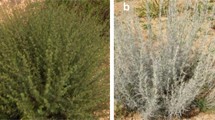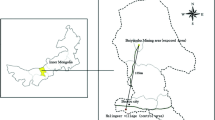Abstract
The aim of this study was to find trace elements that increase risk of breast cancer based on the deviation of the concentration of trace elements in the fingernail collected from the women with breast cancer and the normal women. The study was conducted with 10 elements (As, Au, Br, Co, Cr, Fe, Sb, Sc, Se, and Zn) using k0-INAA and statistical analysis method. Significant differences (P < 0.05) were found for Cr, Fe, Sc and Zn between the case and the control groups. A significant correlation between Fe and Zn has found for the normal women, but this disappears in the women with breast cancer. On the contrary, a significant correlation between As and Cr has found in the case group, but no such correlation has noticed for the control group. The elements Cr, Fe, and Zn may be associated to the risk of breast cancer.
Similar content being viewed by others
References
He Ka (2011) Trace elements in nails as biomarkers in clinical research. Eur J Clin Investig 41:98–102
Gerhardsson L, Englyst V, Lundstrom NG, Sandberg S, Nordberg G (2002) Cadmium, copper and zinc in tissues of deceased copper smelter workers. J Trace Elem Med Biol 16:261–266
Garland M, Morris JS, Coltdiz GA, Stampfer MJ et al (1996) Toenail trace element levels and breast cancer: a prospective study. Am J Epidemiol 144:653–660
Silva MP, Soave DF, Ribeiro-Silva A, Poletti ME (2012) Trace elements as tumor biomarkers and prognostic factors in breast cancer: a study through energy dispersive x-ray fluorescence. BMC Res Notes 5:194
Lappano R, Malaguarnera R, Belfiore A, Maggiolini M (2017) Recent advances on the stimulatory effects of metals in breast cancer. Mol Cell Endocrinol 457:49–56
Navarro Silvera SA, Rohan TE (2007) The trace elements and cancer risk: a review of the epidemiologic evidence. Cancer Causes Control 18:7–27
Arriola H, Longoria L, Quintero A, Guzman D (1999) INAA of trace elements in colorectal cancer patients. Biol Trace Elem Res 71:563–568
Midle D, Altmannova A, Vyslouzil K, Stuzka V (2005) Trace element levels in blood serum and colon tissue in colorectal cancer. Chem Pap 59:157–160
Zaichick V, Zaichick S (2018) Fifty trace element contents in normal and cancerous thyroid. Acta Sci Cancer Biol 2:21–38
Parkin DM, Bray FI, Devesa SS (2001) Cancer burden in the year 2000: the global picture. Eur J Cancer 37:54–66
Najim Safaa (2017) Determination of some trace elements in breast cancer serum by atomic absorption spectroscopy. Int J Chem 9:1–6
Blaurock-Busch E, Busch YM, Friedle A, Buerner H, Parkash C, Kaur A (2015) Comparing the metal concentration in the nails of healthy and cancer patients living in the Malwa region of Punjab, India with a random Euopean group—a follow up study. BJMMR 5:480–498
Scoble HA, Litman R (1978) Preparation of hair and nail samples for trace element analysis. Anal Lett 11:183–189
Memon AR, Kazi TG, Afridi HI, Jamali MK, Arain MB et al (2007) Evaluation of zinc status in whole blood and scalp hair of female cancer patients. Clin Chem Acta 379:66–70
O’Brien KM, White AJ, Sandler DP, Jackson BP, Karagas MR, Weinberg CR (2019) Do post-breast cancer diagnosis toenail trace element concentrations reflect prediagnostic concentrations? Epidemiology 30:112–119
Janbabai G, Alipour A, Ehteshami S, Borhani SS, Farazmandfar T (2018) Investigation of trace elements in the hair and nail of patients with stomach cancer, Indian. J Clin Biochem 33:450–455
Salman M, Rehman R, Anwar J, Mahmud T (2012) Statistical analysis of selected heavy metals by ICP-OES in hair and nails of cancer and diabetic patients of Pakistan. EJEAFChe 11:163–171
Aguiar AR, Saiki M (2001) Determination of trace elements in human nail clippings by neutron activation analysis. J Radioanal Nucl Chem 249:413–416
Xiao L, Zhang YH, Li QG, Zhang QX, Wang K (1995) INAA of elemental contents in fingernails of esophageal cancer patients. J Radioanal Nucl Chem 195:43–49
Wee BS, Ebihara M (2017) Neutron activation analysis and assessment of trace elements in fingernail from residents of Tokyo, Japan. Sains Malays 46:605–613
De Corte F, Simonist A (2003) Recommend nuclear data for use in the k0-standardization of neutron activation analysis. At Data Nucl Data Tables 85:47–67
Dung HM, Hien PD (2003) The application and development of k0-standardization method of neutron activation analysis at Dalat research reactor. J Radioanal Nucl Chem 257:643–647
Bu-Olayan AH, Al-Yakoob SN, Alhazeem S (1996) Lead in drinking water from water coolers and in fingernails from subjects in Kuwait city, Kuwait. Sci Total Environ 181:209–214
Gault AG, Rowlan HAL, Charnock JM, Wogelius RA, Morilla IG et al (2008) Arsenic in hair and nails of individuals exposed to arsenic-rich groundwaters in Kandal, Campodia. Sci Total Environ 393:168–176
Brockman JD, Guthrie JM, Morris IS, Davis J, Madsen R, Robertson JD (2009) Analysis of the toenail as a biomonitor of supranutritional intake of Zn, Cu, and Mg. J Radioanal Nucl Chem 279:405–410
Ho Manh-Dung, Tran Quang-Thien, Ho Van-Doanh, Cao Dong-Vu, Nguyen Thi-Sy (2016) Quality evaluation of the k0-standardized neutron activation analysis at the Dalat research reactor. J Radioanal Nucl Chem 309(1):135–143
Ku HH (1966) Notes on the use of propagation of error formulas. J Res Nat Bur Stand Sect C Eng Inst 70C:263. https://doi.org/10.6028/jres.070C.025
Thomson M, Ellison SLR, Wood R (2006) The international harmonized protocol for the proficiency testing of analytical chemistry laboratories. Pure Appl Chem 78:145–196
Bode P (1996) Instrumental and organization aspects of a neutron activation analysis laboratory. Ph.D. thesis, Delft University of Technology. http://resolver.tudelft.nl/uuid:438b9110-fb94-4015-b277-1c5fba96ac71. Accessed 10 Dec 1996
Akoglu H (2018) User’s guide to correlation coefficients. Turk J Emerg Med 18:91–93
Mukaka MM (2012) Statistics corner: a guide to appropriate use of correlation coefficient in medical research. Malawi Med J 24(3):69–71
Goulle JP, Saussereau E, Mahieu L, Boouige D, Groenwont S, Guerbet M, Lacroix C (2009) Application of inductively coupled plasma mass spectrometry multielement analysis in fingernail and toenail as a biomarker of metal exposure. J Anal Toxicol 33:92–98
Chaudhary K, Ehmann WD, Rengan K, Markesbery WR (1995) Trace element correlations with age and sex in human fingernails. J Radioanal Nucl Chem 195:51–56
Vance DE, Ehmann WD, Markesbery WR (1988) Trace element content in fingernails and hair of a nonindustrialized US control population. Biol Trace Elem Res 17:109–121
Chan S, Gerson B, Subramaniam S (1998) The role of copper, molybdenum, selenium, and zinc in nutrition and health. Clin Lab Med 18:673–685
Christianson DW, Cox JD (1999) Catalysis by metal-activated hydroxide in zinc and manganese metalloenzymes. Annu Rev Biochem 68:33–57
Kist AA, Zhuk LI, Danilova EA, Makhmudov EA (2012) On question of biological role of scandium. Abstracts of international conference on nuclear science and its application. Sect Environ Sci 44(50):389–390
Arhin E, Zango MS (2016) Impact of trace elements in the natural environment and public health: a medical geology perspective. Ann Public Health Res 3:1051
Chan PC, Peller OG, Kesner L (1982) Copper(II)-catalyzed lipid peroxidation in liposomes and erythrocyte membranes. Lipids 17:331–337
Magalova T, Bella V, Brtkova A, Beno I, Kudlackova M, Volkovova K (1999) Copper, zinc and superoxide dismutase in precancerous, benign diseases and gastric, colorectal and breast cancer. Neoplasma 46:100–104
Zaichick V, Zaichick S (2018) Significance of trace element quantities in osteomyelitis and osteosarcoma. Nov Approach Can Study 1:1–11
Garg AN, Weginwar RG, Sagdeo V (1990) Minor and trace elemental contents of cancerous breast tissue measured by instrumental and radiochemical neutron activation analysis. Biol Trace Elem Res 26:485–496
Ebrahim AM, Eltayeb MAH, Shaat MK, Mohmed NMK, Eltayeb EA, Ahmed AY (2007) Study of selected trace elements in cancerous and non-cancerous human breast tissues from Sudanese subjects using instrumental neutron activation analysis. Sci Total Environ 383:52–58
Magalhaes T, Becker M, Carvalho ML, Bohlen A (2008) Study of Br, Zn, Cu and Fe concentrations in healthy and cancer breast tissues by TXRF. Spectrochim Acta B 63:1473–1479
Kwiatek WM, Banas A, Banas K, Gajda M, Galka M, Falkenberg G, Cichocki T (2005) Iron and other elements studies in cancerous and non-cancerous prostate tissues. J Alloys Compd 401:178–183
Magalova T, Brtkova A, Beno I, Mekinova D, Volkovova K, Staruchova M, Tatara M (1997) Levels of Cu, Zn, Se and their relation to levels of ceruloplasmin and the activity of antioxidative enzymes. Bratisl Lek Listy 98:8–11
Choudhury TR, Ali M, Rahin SA, Ali MP (2013) Trace elements in the hair of normal and chronic arsenism people. Glob Adv Res J Environ Sci Toxicol 2:163–173
Campos FI, Carrasquilla G, Koriyama C, Serra M, Carrascal E, Itoh T, Nomoto M (2006) Risk factors of gastric cancer specific for tumor location and histology in Cali, Colombia. World J Gastroenterol 12:5772–5779
Campos FI, Koriyama C, Akiba S, Carrasquilla G et al (2008) Toenail zinc level and gastric cancer risk in Cali, Colombia. J Cancer Res Clin Oncol 134:169–178
Sundar S, Chakravarty J (2010) Antimony toxicity. Int J Environ Res Public Health 7:4267–4277
Cooper RG, Harrison AP (2009) The exposure to and health effects of antimony. Indian J Occup Environ Med 13:3–10
McCallum RI (2005) Occupational exposure to antimony compounds. J Environ Monit 7:1245–1250
Jouybari L, Naz MSG, Sanagoo A, Kiani F, Sayehmiri F et al (2018) Toxic elements as biomarkers for breast cancer: a meta-analysis study. Cancer Manag Res 10:69–79
Singh J, Carlisle DL, Pritchard DE, Patierno SR (1998) Chromium- induced genotoxicity and apoptosis: relationship to chromium carcinogenesis (review). Oncol Rep 5:1307–1325
Ionescu JG, Novotny J, Stejskal V, Latsch A, Blaurock-Busch E, Eisemann-Klein M (2006) Increased levels of transition metals in breast cancer tissue. Neuro Endocrinol Lett 27:36–39
Acknowledgements
This research is funded by the Vietnam National Foundation for Science and Technology Development (NAFOSTED) under grant number 103.04-2017.311. The authors thank the staff of INAA Lab, Dalat Nuclear Research Institute, supported during neutron irradiation. Thank to doctor - nurses in the Department of Oncology, Dong Nai General Hospital, supported for sample collection.
Author information
Authors and Affiliations
Contributions
All authors contributed to the study conception and design. Material preparation, data collection and analysis were performed by Huynh Truc Phuong, Tran Tuan Anh, Tran Pham Ngoc Trinh, and Nguyen Thi Truc Linh. The first draft of the manuscript was written by Huynh Truc Phuong and all authors commented on previous versions of the manuscript. The manuscript was edited and revised by Nguyen Van Dong. All authors read and approved the final manuscript.
Corresponding author
Ethics declarations
Conflict of interest
We have no conflict of interest.
Research involving human participants and/or animals
Research has carried out on the fingernail of breast cancer patients.
Informed consent
This study was approved by the ethics committee of Dong Nai General Hospital and participants.
Additional information
Publisher's Note
Springer Nature remains neutral with regard to jurisdictional claims in published maps and institutional affiliations.
Rights and permissions
About this article
Cite this article
Huynh, P.T., Tran, T.P.N., Dinh, B.T. et al. Analysis of trace elements in the fingernails of breast cancer patients using instrumental neutron activation analysis. J Radioanal Nucl Chem 324, 663–671 (2020). https://doi.org/10.1007/s10967-020-07093-w
Received:
Published:
Issue Date:
DOI: https://doi.org/10.1007/s10967-020-07093-w




